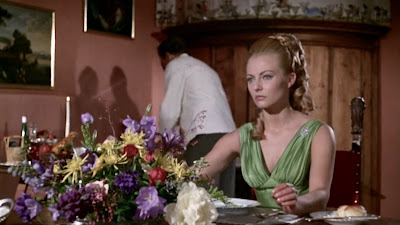Following her death last year I decided to explore Karin Baal’s career a little bit.
Having had no previous acting experience and coming from a poor working class background, the 15-year old Baal was instantly catapulted to stardom when she was chosen as the female lead next to Horst Buchholz in the juvenile delinquency drama Die Halbstarken/Teenage Wolfpack (1956) in which she played a seductive rebellious teenager.
Given her lack of acting nous for this production she was dubbed by Brigitte Grothum (who would later also feature in Das Gasthaus an der Themse/The Inn on the River and the CCC Wallace Der Fluch der gelben Schlange/The Curse of the Yellow Snake).
The film was not just a tremendous success at the box office but it aligned with the Zeitgeist and struck a chord with the post-war generation for whom Baal became an instant icon.
Baal became known as the “German Brigitte Bardot” and for a while was typecast in roles similar to the ones she had played for her debut.
Over a decade, she appeared in three Rialto Wallaces and with her roles went from naive ingénue to confident young woman and middle aged wife.
In Die toten Augen von London/Dead Eyes of London (1961), she is Nora Ward who first assists Fuchsberger’s inspector with reading messages in braille and then becomes a crucial part of the mystery.
In Der Hund von Blackwood Castle/The Monster of Blackwood Castle (1968) she plays the stylish heiress of a mysterious castle that becomes the focal point for a series of strange killings.
She reunited with Fuchsberger for the Krimi/Giallo hybrid Das Geheimnis der grünen Stecknadel/What Have You Done to Solange?/Cosa avete fatto a Solange? (1972) in which she is the frumpy wife of Fabio Testi's philandering sports and Italian teacher. Once she learns to accept her husband’s slimy cheating ways she dons eye shadow again, wears a negligée and lies lasciviously on her bed when not helping him to investigate the murders and free him from suspicion.
Baal starred next to Oliver Reed in Michael Winner’s Hannibal Brooks (1969) though international stardom eluded her.
She was, however, a constant feature in German cinemas, on TV as well as on stage. In the 1980s she became a muse for Rainer Werner Fassbinder and featured in three of his productions: the then controversial TV series Berlin Alexanderplatz (1980) and the two movies Lili Marleen und Lola (both 1981).
She can also be seen in Hans-Christoph Blumenberg’s Tausend Augen (1984, tr. “Thousand Eyes”) in which she plays an elderly ticket lady at a strip joint who spies on her boss to the female head of a mafia-like ring of video pirates. Despite not being an actual Mabuse film, this movie does carry a lot of Mabusian references and undertones.
Though professionally successful and publicly celebrated, Baal’s private life was often turbulent. She was married four times, battled alcoholism and, not having properly secured her finances in preparation for retirement, faced poverty in her old age.
She published her memoirs in 2012 under the title Ungezähmt: Mein Leben (tr. "Untamed: My Life").




.jpg)


